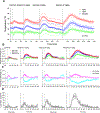Basic metabolic and vascular effects of ketamine and its interaction with fentanyl
- PMID: 36801400
- PMCID: PMC10006345
- DOI: 10.1016/j.neuropharm.2023.109465
Basic metabolic and vascular effects of ketamine and its interaction with fentanyl
Abstract
Ketamine is a short-acting general anesthetic with hallucinogenic, analgesic, and amnestic properties. In addition to its anesthetic use, ketamine is commonly abused in rave settings. While safe when used by medical professionals, uncontrolled recreational use of ketamine is dangerous, especially when mixed with other sedative drugs, including alcohol, benzodiazepines, and opioid drugs. Since synergistic antinociceptive interactions between opioids and ketamine were demonstrated in both preclinical and clinical studies, such an interaction could exist for the hypoxic effects of opioid drugs. Here, we focused on the basic physiological effects of ketamine as a recreational drug and its possible interactions with fentanyl-a highly potent opioid that induces strong respiratory depression and robust brain hypoxia. By using multi-site thermorecording in freely-moving rats, we showed that intravenous ketamine at a range of human relevant doses (3, 9, 27 mg/kg) dose-dependently increases locomotor activity and brain temperature, as assessed in the nucleus accumbens (NAc). By determining temperature differentials between the brain, temporal muscle, and skin, we showed that the brain hyperthermic effect of ketamine results from increased intracerebral heat production, an index of metabolic neural activation, and decreased heat loss due to peripheral vasoconstriction. By using oxygen sensors coupled with high-speed amperometry we showed that ketamine at the same doses increases NAc oxygen levels. Finally, co-administration of ketamine with intravenous fentanyl results in modest enhancement of fentanyl-induced brain hypoxia also enhancing the post-hypoxic oxygen increase. Therefore, in contrast to fentanyl, ketamine increases brain oxygenation but potentiates brain hypoxia induced by fentanyl.
Keywords: Brain hypoxia; Brain oxygen; Brain temperature; Hyperoxia; Metabolic brain activation; Oxygen sensors; Peripheral vasoconstriction; Respiratory depression.
Published by Elsevier Ltd.
Conflict of interest statement
Declaration of competing interest The authors report no conflict of interest.
Figures




Similar articles
-
Brain oxygen responses induced by opioids: focus on heroin, fentanyl, and their adulterants.Front Psychiatry. 2024 Jan 17;15:1354722. doi: 10.3389/fpsyt.2024.1354722. eCollection 2024. Front Psychiatry. 2024. PMID: 38299188 Free PMC article. Review.
-
Heroin Contaminated with Fentanyl Dramatically Enhances Brain Hypoxia and Induces Brain Hypothermia.eNeuro. 2017 Oct 30;4(5):ENEURO.0323-17.2017. doi: 10.1523/ENEURO.0323-17.2017. eCollection 2017 Sep-Oct. eNeuro. 2017. PMID: 29085909 Free PMC article.
-
Fentanyl-Induced Brain Hypoxia Triggers Brain Hyperglycemia and Biphasic Changes in Brain Temperature.Neuropsychopharmacology. 2018 Mar;43(4):810-819. doi: 10.1038/npp.2017.181. Epub 2017 Aug 29. Neuropsychopharmacology. 2018. PMID: 28849778 Free PMC article.
-
Xylazine effects on opioid-induced brain hypoxia.Psychopharmacology (Berl). 2023 Jul;240(7):1561-1571. doi: 10.1007/s00213-023-06390-y. Epub 2023 Jun 21. Psychopharmacology (Berl). 2023. PMID: 37340247 Free PMC article.
-
Respiratory depression and brain hypoxia induced by opioid drugs: Morphine, oxycodone, heroin, and fentanyl.Neuropharmacology. 2019 Jun;151:219-226. doi: 10.1016/j.neuropharm.2019.02.008. Epub 2019 Feb 5. Neuropharmacology. 2019. PMID: 30735692 Free PMC article. Review.
Cited by
-
Comparison of the anesthetic effect of sufentanil versus fentanyl in pediatric surgical patients: a meta-analysis.Am J Transl Res. 2024 Nov 15;16(11):6225-6235. doi: 10.62347/XRDG3903. eCollection 2024. Am J Transl Res. 2024. PMID: 39678617 Free PMC article. Review.
-
Brain oxygen responses induced by opioids: focus on heroin, fentanyl, and their adulterants.Front Psychiatry. 2024 Jan 17;15:1354722. doi: 10.3389/fpsyt.2024.1354722. eCollection 2024. Front Psychiatry. 2024. PMID: 38299188 Free PMC article. Review.
-
Hypoxic effects of heroin and fentanyl and their basic physiological mechanisms.Am J Physiol Lung Cell Mol Physiol. 2024 Dec 1;327(6):L930-L948. doi: 10.1152/ajplung.00251.2024. Epub 2024 Oct 15. Am J Physiol Lung Cell Mol Physiol. 2024. PMID: 39404797 Review.
References
-
- Alvarez P, Saavedra G, Hernandez A, Paele C, Pelissier T, 2003. Synergistic antinociceptive effects of ketamine and morphine in the orofacial test in rats. Anesthesiology 99, 959–75. - PubMed
-
- Ben-Shlomo I, Rosenbaum A, Hadash O, Katz Y, 2001. Intravenous midazolam signficantly enhances the lethal effect of theopental but not that of ketamine in mice. Pharmac. Res 44, 509–12. - PubMed
-
- Bolger FB, Bennett R, Lowry JP, 2011. An in vitro characterisation comparing carbon paste and Pt microelectrodes for real-time detection of brain tissue oxygen. Analyst 136, 4028–35. - PubMed
Publication types
MeSH terms
Substances
Grants and funding
LinkOut - more resources
Full Text Sources

